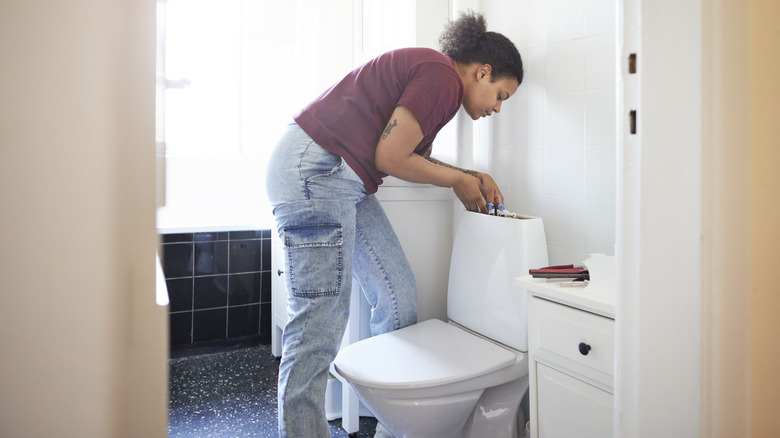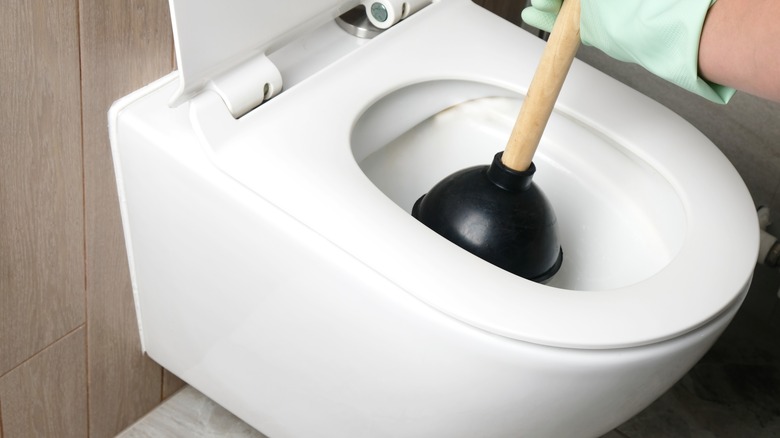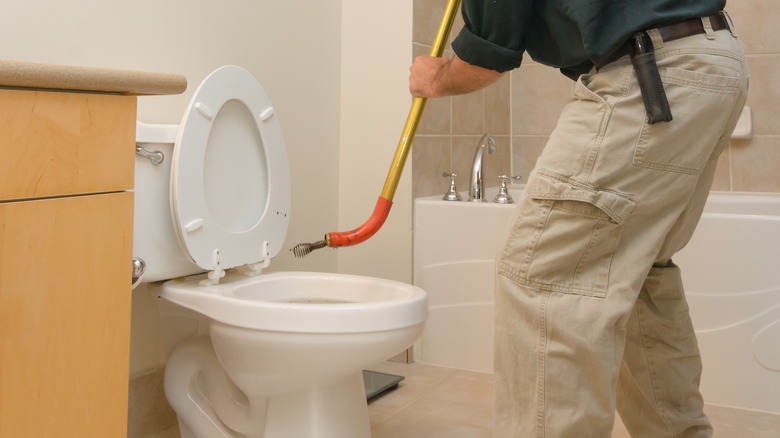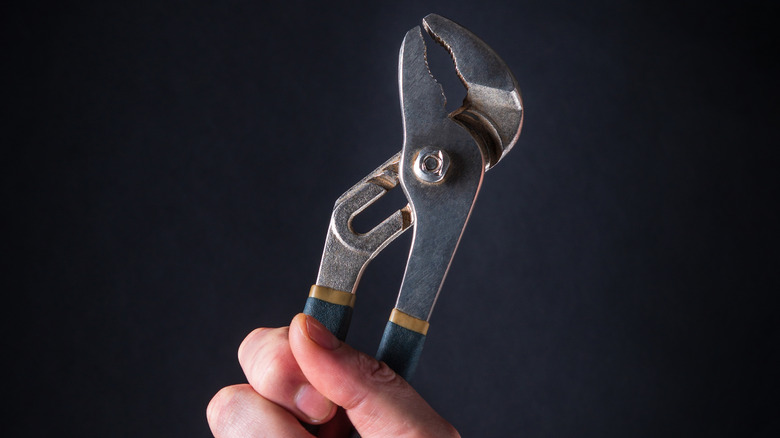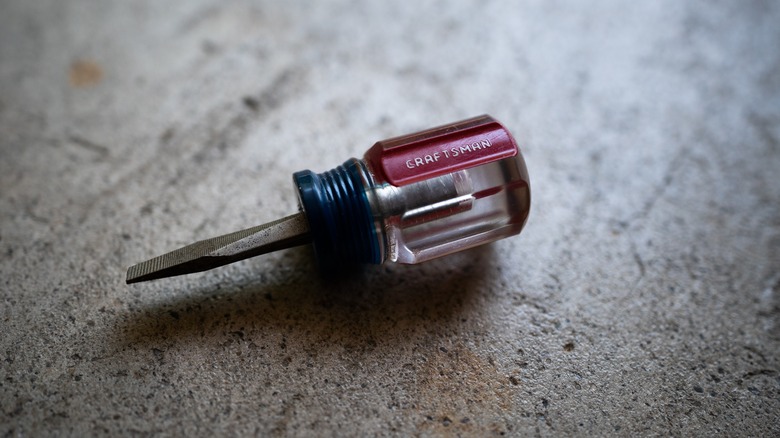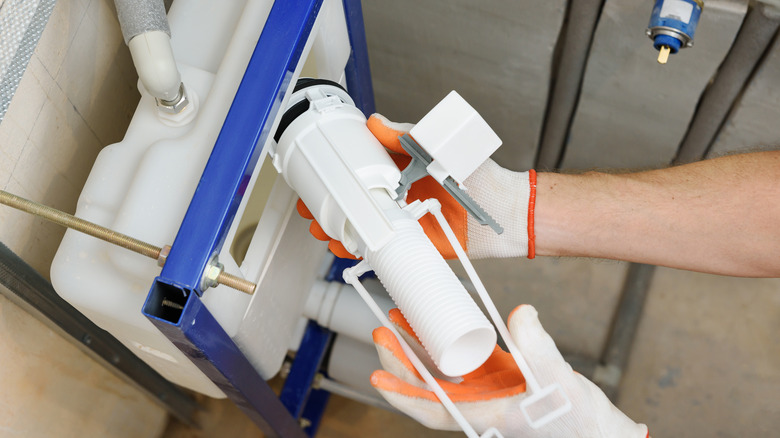Plumbing Tools For Toilets That Every Homeowner Should Have On Hand
We may receive a commission on purchases made from links.
The average cost to call out a plumber can range from $45 to $150 per hour. While this is certainly justified when you consider the experience, materials, and work required to complete a major repair, it can start to quickly drain your bank account if you have to rely on a plumber every time you face a smaller issue with your toilet. Because of this, it's incredibly beneficial to arm yourself with knowledge and a few simple tools, so you're able to complete these minor repairs yourself. You won't become a professional overnight, and there are plenty of cases where you should call in someone with more experience, but with these tools, like a basic plunger and toilet auger, can save you quite a bit of time and money.
Learning to repair a toilet can seem intimidating at first glance, but it's actually a pretty simple mechanism once you wrap your mind around how your toilet parts work. Thankfully, there are plenty of helpful videos and tutorials online that can give you step-by-step instructions on how to fix just about any common problem. These repairs do, however, sometimes require specialized tools that go beyond what you might already have on hand. But, as soon as you gather a couple of must-haves, you'll be good to go.
Plunger
Of all of the tools on this list, the plunger is the one that you're most likely to already have on hand. Unfortunately, however, many people only realize they need a plunger once they're already facing a clog. If you've been putting off buying a plunger because you don't think you'll ever actually use it, now is your sign to pick one up next time you're out shopping.
Typical plungers consist of a rubber cup attached to a stick. When placed in the toilet, this rubber piece creates a seal around the drain, allowing you to create pressure in the pipe and dislodge minor clogs. Because there's a stick on the end, you don't have to get too close to the toilet bowl or actually touch anything in the process of clearing the drain. It is possible to clear some clogs without a plunger, but it's much more convenient and a significantly less hands-on with one. If you have a flange plunger (the option with an additional piece of rubber on the bottom) it can also be used to help unclog your drain if you're facing blockages in your shower or sink.
Toilet auger
If you're facing a clog that isn't clearing up with the help of a plunger, it might be time to bring in the big guns. Toilet augers are specially-designed tools meant to fit into the pipes in your toilet, break up the clog, and push any material through. These long, tube-like tools perform a similar function to toilet snakes, but rather than latching on to and removing the clog, they typically keep it moving through the pipe.
To use a toilet auger, place the curved end in your toilet and begin cranking the handle. This will move the end of the auger towards the clog without you having to get your hands dirty. Keep cranking until you get some resistance, then apply some pressure to push the clog forward. This action will help to break up the material, move it along, or lodge it in the auger itself, allowing you to clear the pipe once you remove the tool. Once you're done, flush your toilet to ensure everything is back to functioning normally. You might have to try this a couple times if you're not noticing an improvement, but this should help to tackle pretty much any blockage that's too stubborn for your plunger.
Channel lock pliers
If you're looking for a versatile, multi-use tool to keep in your kit, channel lock pliers should be your first choice. It's likely that, if you already have a basic toolkit, you have a pair of needle-nose pliers on hand. While these are great for gripping onto items and giving you more control, channel lock pliers can be used for a larger number of tasks, especially when it comes to making simple repairs on your toilet. Despite the fact that they're called pliers, they can also be used as a clamp or adjustable wrench when needed.
This is because channel lock pliers can be calibrated to fit around different-sized objects thanks to their adjustable jaws. This will allow you to get a better grip on anything from a small bolt to a large pipe. Because they typically have longer handles, they also provide a large amount of torque, helping you to more easily unscrew or loosen items that have been tightly secured. Plumbing repairs often require you to work at awkward angles, on slippery or wet surfaces, or in areas that you can't easily access with just your hands, so having some channel lock pliers around can give you the extra help you need to more easily complete the job.
Stubby screwdrivers
One of the things that makes repairing a toilet more difficult than other tasks is the fact that you're often having to deal with awkward angles and tight spaces. In these situations, stubby screwdrivers will be your best friends. They might look like a children's toy at first glance, but these smaller screwdrivers have a shorter handle so you can more easily fit into tight spots. As an added bonus, they take up much less space if you're looking to keep your repair kit concealed in the bathroom. You also can cut down the number of items you have to store by looking for a stubby screwdriver with interchangeable bits that can be modified to fit your needs.
To add an extra layer of convenience, you can also pick up a stubby screwdriver with a magnetized head, like the Stubby Magnetic Screwdriver with Phillips Head and Flat Head from Amazon for $10. Thanks to the magnetic tip, these screwdrivers will easily attach to the screws — a major help if you're working in a tight corner behind the toilet where dropping a screw means you have to spend the next five minutes blindly searching for it.
Flush valve repair kit
Clogs are by far the most common issue that homeowners face with their toilets, but a constantly running toilet is definitely a close second. If you find that this is a common problem for you, you're likely dealing with a malfunctioning flush valve. It's necessary for this mechanism to create a proper seal between flushes, and if it doesn't, you're stuck with that annoying constant hissing noise that can wreak havoc on your water bill.
To prepare yourself and make sure you have everything you need on hand to perform this repair down the line, it can be a good idea to invest in a flush valve repair kit that you know is compatible with your toilet. These will typically only run you around $20 and can be installed on your own with a bit of work, helping you to save yourself a ton of money on a plumber. The kit should contain everything you need for the repair including a new valve, the necessary hardware, and sometimes even a handle, so you'll be good to go as soon as the need arises.
